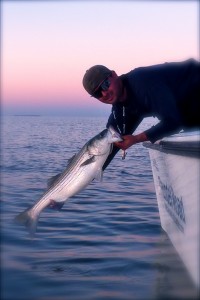 Since I’ve been reporting bigger migratory fish on my recent trips, I’ve been overwhelmed with questions about where the fish are. My apologies if I’ve yet to return a call or answer an email, but the absolute truth is – I don’t know. These big fish are moving around very quickly and they haven’t been at the same place twice. I think we sometimes put too much emphasis on locations, and not enough on patterns. Tell someone where to go to catch a fish and you may help them for a day, but teach them how to identify specific patterns of how fish behave, and you’ve helped them for a lifetime. Ask any good fisherman the secret to repeated success and he’ll tell you it’s the ability to distinguish specific feeding habits. I believe that you can drop a good fisherman into any body of water in the world and he’ll catch fish as long as you give him enough time to establish a prevailing pattern. It’s especially important on the Chesapeake where conditions change quickly and a rapid thirty degree temperature drop in October is not unusual. I think fishing conditions change faster and more often here than anywhere I’ve fished before. Fortunately, fish are usually creatures of habit and there are distinct patterns we can identify in the way they behave.
Since I’ve been reporting bigger migratory fish on my recent trips, I’ve been overwhelmed with questions about where the fish are. My apologies if I’ve yet to return a call or answer an email, but the absolute truth is – I don’t know. These big fish are moving around very quickly and they haven’t been at the same place twice. I think we sometimes put too much emphasis on locations, and not enough on patterns. Tell someone where to go to catch a fish and you may help them for a day, but teach them how to identify specific patterns of how fish behave, and you’ve helped them for a lifetime. Ask any good fisherman the secret to repeated success and he’ll tell you it’s the ability to distinguish specific feeding habits. I believe that you can drop a good fisherman into any body of water in the world and he’ll catch fish as long as you give him enough time to establish a prevailing pattern. It’s especially important on the Chesapeake where conditions change quickly and a rapid thirty degree temperature drop in October is not unusual. I think fishing conditions change faster and more often here than anywhere I’ve fished before. Fortunately, fish are usually creatures of habit and there are distinct patterns we can identify in the way they behave.
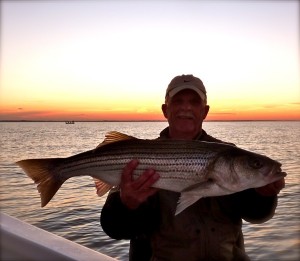 I’ve talked about specific seasonal conditions in previous articles, so I won’t go over them again, but I’ll say here that you need a basic knowledge of how striped bass behave in relation to the time of year before you can really start identifying patterns. Here’s a good place to start reading. Additionally, the editors of this year’s The Maryland Fisherman’s Annual were nice enough to ask me to put together a chart about where I fish through specific months of the year. You can find it in the print issue of the magazine which is available at local baitshops and bookstores or online at their website. In the chart, I singled out October with a special comment because fish behave a little differently now than in other months. The secret to finding the big boys and girls is to follow the big bait.
I’ve talked about specific seasonal conditions in previous articles, so I won’t go over them again, but I’ll say here that you need a basic knowledge of how striped bass behave in relation to the time of year before you can really start identifying patterns. Here’s a good place to start reading. Additionally, the editors of this year’s The Maryland Fisherman’s Annual were nice enough to ask me to put together a chart about where I fish through specific months of the year. You can find it in the print issue of the magazine which is available at local baitshops and bookstores or online at their website. In the chart, I singled out October with a special comment because fish behave a little differently now than in other months. The secret to finding the big boys and girls is to follow the big bait.
The favorite baitfish of rockfish in the Chesapeake Bay is Atlantic Menhaden. There’s only one problem. Because of too much commercial harvesting, menhaden stocks are dwindling. There are usually only small pods of menhaden (or bunker as they’re commonly called) scattered across the Bay in the fall. The days of mile long bait schools in the Chesapeake are long gone. Jigging under isolated menhaden schools can produce nice fish in late spring, but in the fall, it’s important to find the heaviest concentrations of the biggest and most mature bunker in the Bay. How do you do it? Patterns. Menhaden behave in patterns just like other fish. Like migratory stripers, they head south toward warmer water as winter approaches. Since menhaden spawn in the tributaries of the Chesapeake Bay in the fall, October rockfish know they can cut them off at the pass by staying close to the mouths of the big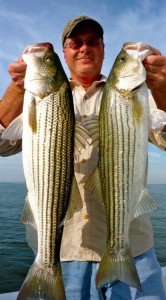 gest rivers.
gest rivers.
Rockfish also love alewife and blueback herring. Collectively known as river herring, they spawn in the spring, The young herring stay in the fresher water of the Chesapeake rivers until water temperatures drop in the fall. In October, they start their migration toward their parents who are already back in the Atlantic Ocean. Just like menhaden, the stripers are waiting to ambush them on their way out of the rivers.
Birds recognize the migration patterns as well. Gulls and terns look for rockfish ambushing bait because they can score free meals as the stunned or mangled bunker floats to the surface. Remember though, it takes a big bird to scarf down a mature 15 inch menhaden. This fall and last I’ve even seen bald eagles diving into the striper blitzes. Unless it’s a really tough day, there’s not much point in fishing under the huge flocks of juvenile gray-winged gulls that are so plentiful this time of year. Those little birds will only be over little fish. Just like the juvenile stripers and rockfish beneath them, the young seagulls are learning their skills of how to catch small bait like rain minnows and bay anchovies. You might get lucky and get a keeper beneath small gulls once in a while, but if you’re looking for bigger fish, look for birds that are big enough to eat the biggest bait.
Like our prey, fishermen are also creatures of habit. It’s normal human behavior to go back to the same spot where we’ve been successful in the past. Unfortunately, the fish aren’t always there. Changing weather and current conditions make thngs especially tough in October. As the old saying goes, if you don’t like the weather, stick around and it’ll change. There isn’t much we can do about it, we just fish when we can. The condition we can manage best is current. We do that by fishing around locations that are most favorable. In areas where the current is highest, menhaden have to concentrate more effort in swimming against the flow, so they have less time to look out for predators. Stripers know this and that’s where they attack.
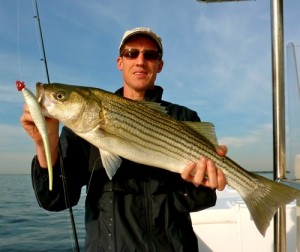 Since we get two tide cycles a day on the Chesapeake, our currents are always changing. The best plan is to study the ebb and flow and watch how it behaves in different situations. In October, pay particularly close attention to places where the flow sweeps against shallow ledges, especially near the mouths of the big rivers. Areas of backflow – places where the current seems to go against the prevailing direction of the tide – are especially productive. A good tool is the graphs produced by the Chesapeake Bay Operational Forecast System (CBOFS). They publish regularly updated charts that predict how currents might behave from day to day.
Since we get two tide cycles a day on the Chesapeake, our currents are always changing. The best plan is to study the ebb and flow and watch how it behaves in different situations. In October, pay particularly close attention to places where the flow sweeps against shallow ledges, especially near the mouths of the big rivers. Areas of backflow – places where the current seems to go against the prevailing direction of the tide – are especially productive. A good tool is the graphs produced by the Chesapeake Bay Operational Forecast System (CBOFS). They publish regularly updated charts that predict how currents might behave from day to day.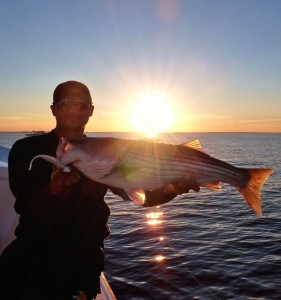 They’re never entirely accurate, but it shows how the flow can go one way, then another depending on tidal conditions. Compare the CBOFS graphs to nautical charts that show bottom contour, look for back-flow where there is big bait, and you’ll be well on your way to planning a productive fishing day.
They’re never entirely accurate, but it shows how the flow can go one way, then another depending on tidal conditions. Compare the CBOFS graphs to nautical charts that show bottom contour, look for back-flow where there is big bait, and you’ll be well on your way to planning a productive fishing day.
I’ve made it out in the late evenings a few times this week with good results. The biggest fish so far has been a forty-incher caught in sixteen feet of water near a shallow ledge at the mouth of a local river. Once I find the fish I’m matching the hatch with my lures by throwing ten inch Bass Kandy Delights (BKDs) and the biggest top-water plugs I can find. By big plugs, I mean bigger than the usual Stillwater Smackits or Super Spooks I sometimes throw. Heavy wood-chopper spooks or giant musky poppers will work. If you can find an eight or ten inch top-water plug, use it when the fish are feeding on or near the surface on the big bait.
I’ve been lauching close to home and going either north or south depending on currents and conditions. It usually takes some looking and running around, but following these techniques I’ve been fortunate enough to hit some quality fish every time I’ve been out. I’ve also received reports of nice fish near the mouths of the western shore rivers including the Severn, South, and Patapsco. Some of the fish have sea lice indicating they’ve recently moved into the Bay from the Atlantic ocean. I’ll go on record for saying I think some of these fish come in through the Chesapeake and Delaware Canal. It’s October, and good things are happening. With unsettled weather on the horizon and a full moon around the corner, it will only get better.




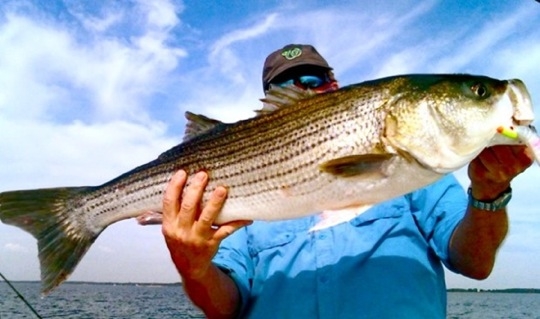
Looking good there SK…save some for me..be home mid-day mon…
You guys are all over those fish like white on rice!
Excellent read…Shawn,Thanks